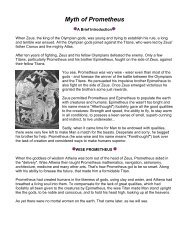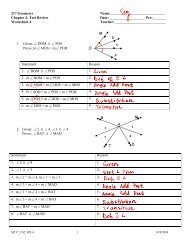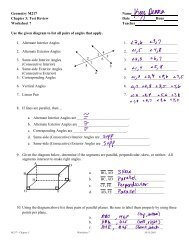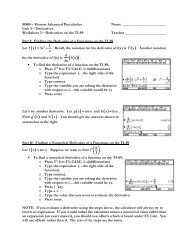You also want an ePaper? Increase the reach of your titles
YUMPU automatically turns print PDFs into web optimized ePapers that Google loves.
Children During <strong>World</strong> <strong>War</strong> <strong>II</strong><br />
Shortly after the United States entered the war, President Roosevelt declared in a fireside chat that there is "one front<br />
and one battle where everyone in the United States-every man, woman, and child-is in action. That front is right here at<br />
home." Children on the home front rallied to the war effort by participating in scrap-metal drives, earning money for war<br />
bonds, and joining the labor force. They were also impacted by the war in profound ways because of unprecedented<br />
family mobility, widespread employment of women, and the prolonged absence of fathers called to service.<br />
Family mobility during the war created numerous challenges for families and children. In the three and one-half years<br />
after the United States joined the war, 12 million men left home to enter the armed services and more than 15 million<br />
civilians moved to new homes. Most of them moved to industrial centers in search of jobs, but some moved to be closer<br />
to military bases. Thus, millions of American children had to adjust to being uprooted from familiar surroundings, to the<br />
prolonged absence of their fathers, and to reduced attention from their parents. One of the most difficult adjustments for<br />
families was the loss of a father to the armed services and the constant anxiety about his safety and well-being.<br />
In addition, as upward of 16 million women worked full time outside the home during the war, more and more children<br />
were separated from both parents for long periods. Due to the near-absence of supportive community services such as<br />
childcare centers and communal kitchens, children sometimes suffered from diminished attention or even neglect. And,<br />
since many schools were overcrowded, some children could only attend school for half the day. The children left to fend<br />
for themselves while their mothers worked were called "latchkey children" or "eight-hour orphans" and were a cause for<br />
great concern. In 1940 Congress passed the Lanham Act to give federal aid to communities that had to accommodate<br />
large war-related populations. The act provided funds for daycare centers, hospitals, sewer systems, police and firefighting<br />
facilities, and recreation centers. But care was provided for only 107,000 children. Many children who did not<br />
receive care wandered the streets or were locked in cars or sent to all-day, and sometimes even all-night, movies. In<br />
one area devoted to war industry in Los Angeles, one social worker discovered 45 infants locked in cars in a parking lot.<br />
The war also changed the lives of many adolescents. Between 1940 and 1944, the number of teenagers attending<br />
school declined by 12.5 million, and most who left school took jobs. As a result, the previous trend toward reduced child<br />
labor was temporarily reversed. The number of teenage workers spiraled from one to over three million-one-third of their<br />
age group-which meant that four times as many 14- and 15-year-old girls were working at the end of the war than at the<br />
start. Not only were more young people working, but they were performing heavier work in industries such as<br />
manufacturing.<br />
The wartime increase in child labor meant the loss of education for children, as well as an increase in illegal<br />
employment. In New York, for example, the number of boys and girls illegally employed jumped by nearly 400 percent. A<br />
survey of pinsetters in bowling alleys showed that "boys as young as nine years go to the alleys after school, eat supper<br />
in an upstairs or back room, and work until midnight on school nights and until 3 or 4 o'clock in the morning on Sunday."<br />
Working for long hours, and late at night, left children fatigued during school and contributed to the increasing number of<br />
students who did not finish school.<br />
One indicator of the difficult adjustments children had to make during the war was the surge in juvenile crime. Juvenile<br />
arrests climbed 20 percent nationwide in 1943. In San Diego, arrests increased 55 percent for boys and 355 percent for<br />
girls. Promiscuity rose among young women, and many girls became prostitutes. Arrests for the crime soared 68<br />
percent. Among boys, theft was the most common crime, but vandalism and violence were also problems.<br />
Perhaps due to statistics on crime and dropout rates, the massive positive contributions children made to the war effort<br />
were often overlooked or minimized. Taking part in home front activities provided children with a real sense of<br />
involvement in the war. Children gave their own nickels and dimes to buy war stamps and bonds, ultimately contributing<br />
over 100 million dollars to the war effort. They also took a particularly active role in community drives to collect scrap<br />
metal, paper, and rubber, all of which were needed to meet the rapid growth of U.S. industrial production. Heeding the<br />
words of a Bing Crosby song that said, "Junk ain't junk no more/Cause junk can win the war," children launched tireless<br />
efforts to collect scrap metal to be converted into bombs and shells. Giving themselves such names as the "Tin-Can<br />
Colonels" and "Uncle Sam's Commandos," groups of children rummaged through attics, emptied garages, and pulled<br />
their wagons through the streets looking for discarded pots, pans, tin cans, bedsprings, and other scrap metal. They<br />
even made door-to-door collections of aluminum.<br />
Children also collected waste paper, which was made into the cartridge belts used to carry ammunition. In Chicago<br />
schools, for example, every Wednesday was "Paper Day" and students brought bundles of newspapers to school where<br />
the teacher measured them. The student who brought the thickest pile of papers was awarded a gold pin for the week.<br />
In just five months, Chicago schoolchildren collected 18,000 tons of newspapers. The Boy Scouts were another group<br />
that was particularly responsive to the call for rubber and scrap metal, collecting a total of 109 million pounds of rubber<br />
and 370 million pounds of scrap metal.
















